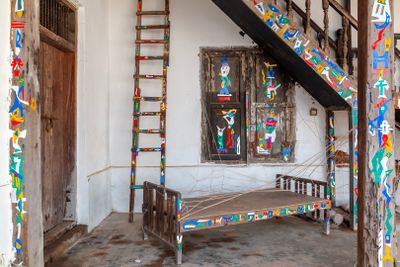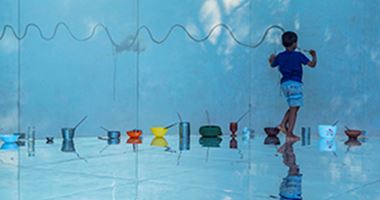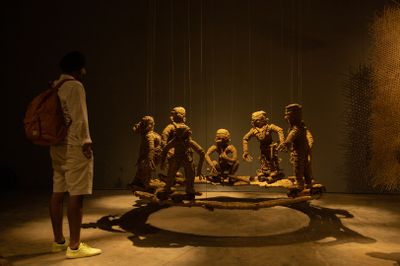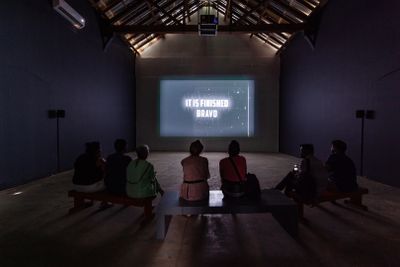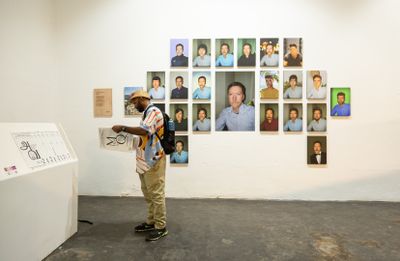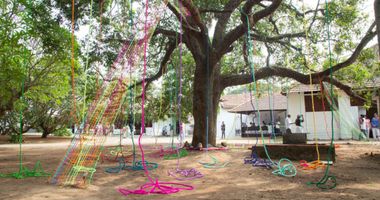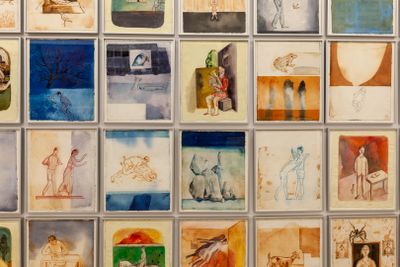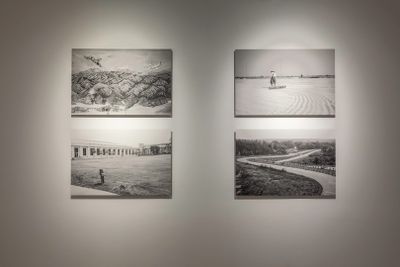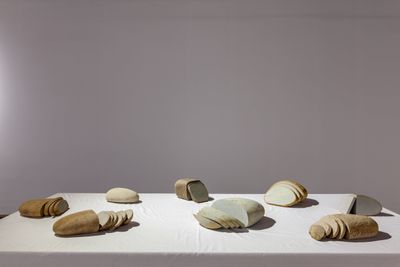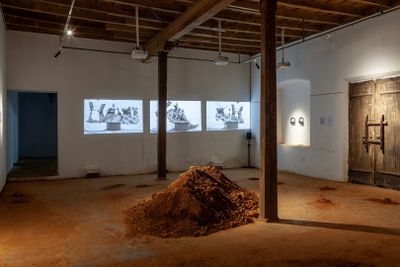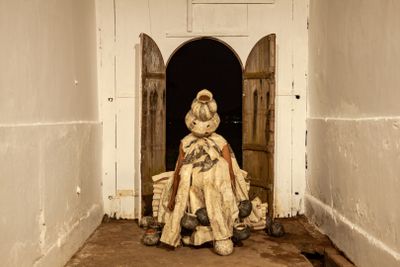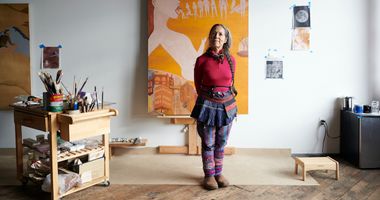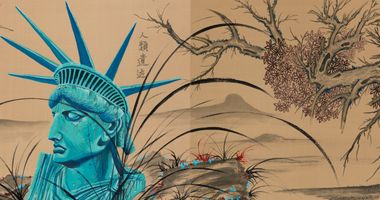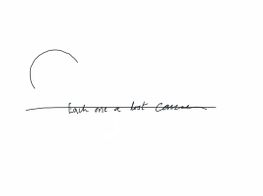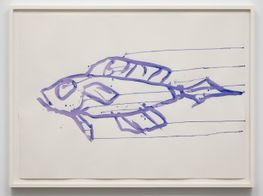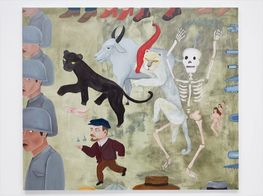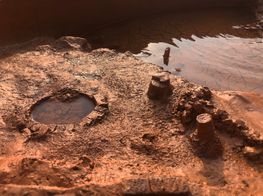Despite Hard Questions, Kochi-Muziris Biennale Deserves a Chance
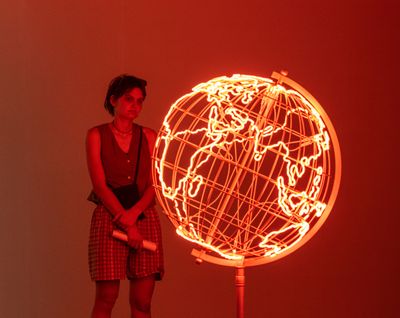
Exhibition view: KNMA, In Our Veins Flow Ink and Fire, 5th Kochi-Muziris Biennale (23 December 2022–10 April 2023). Courtesy 5th Kochi-Muziris Biennale.
Originally scheduled to open in 2020, the fifth edition of the Kochi-Muziris Biennale, titled In Our Veins Flow Ink and Fire (23 December 2022–10 April 2023) has finally come into view.
Having been delayed multiple times due to the pandemic, all the signs of a promising, delectable, and expansive exhibition of 'south to south' art, ideas, and celebration were there in the lead up to the opening: artist lists were announced; programmes were published; the buzz was palpable.
But just as the excitement seemed to reach its peak, everything spun into disarray. Citing 'organisational challenges, compounded by external factors', the Biennale's management delayed the opening once again—just one day before one of South Asia's largest forums for contemporary art was set to commence.
The fallout was swift and furious. An open letter from over 40 participating artists condemned the Biennale management's eleventh-hour decision to postpone, which disappointed and dreadfully inconvenienced numerous artists and visitors who had already travelled to Kerala.
The statement details technical, logistical, and communication challenges that artists faced as they worked feverishly to install their work. Underscoring that these are not new frustrations, the artists point out that such struggles have 'been present in past editions as well'.
What the statement makes clear is that the artists take issue with the Biennale's management rather than its artistic direction led by curator Shubigi Rao, emphasising that responsibility for creating good working conditions for artists and curators rests solely with the organisers.
Rao's curatorial note seemed to anticipate the tumult. 'As a bulwark against despair the biennale as commons may seem an impossible idea,' she writes. 'But we remember the ability of our species, our communities, to flourish artistically even in fraught and dire situations.'
While this KMB edition joins other large-scale exhibitions in adhering to an open, decentralised thematic framing, it became near-impossible to view the works by 88 artists across four main exhibition sites, without also thinking about questions of sustainability, viability, scale, and local economic contexts and environments related to art exhibitions.
And now for the good news: there is so much evocative, poignant, and moving art on display at KMB that it all quickly, if not entirely, subsumes the surrounding challenges—a testament to Rao's curatorial.
At Aspinwall House, among the Biennale's main sites, works ranging from massive site-specific installations to video-based works offer thoughtful, care-filled, and sensorially diverse entries into human experiences and struggles to make meaning of our collective lives.
Tenzing Dakpa's photographic series 'The Hotel' (2015–2017) beautifully renders the power and endurance of familial relationships. Notions of home and origination are evoked across black-and-white hotel scenes, objects, and video recordings of the artist's family, who operate and live within a small hotel in Gangtok, Northeast India.
As we follow their quotidian tasks connected to eking out a living and making it to another day, it is suggested that overwhelming if constrained bonds of love and relation are all we need.
Multiple photographic and film works by late Pakistani artist Madiha Aijaz, including These Silences Are All the Words (2017–2018) and Memorial for the Lost Pages (2018), look at how relationships not only form vital points of connection but become bulwarks against the disappearance of cultures.
Aijaz's work highlights colonial impacts on Karachi as English becomes an ever-dominant force, pushing Urdu language, literature, and intellectual traditions to the periphery, while examining how intimacy and a dogged commitment to remembrance keeps our endangered cultures alive.
This sense of impending loss continues in two achingly haunting works by Myanmarese artist Min Ma Naing. The first, 'Faces of Change' (2021), features coloured portraits of protestors who challenged the military regime, their faces layered over images of large-scale protests against the 2021 coup d'état in Myanmar.
Similarly, 'But In My Dreams' (2022–ongoing) is a series of dream-like photographs showing refugees in the U.S. participating in gatherings meant to sustain memory and cultural practices in exile.
While the power of storytelling, community, and resilience are featured subjects at this Biennale, some works tackle current geopolitical conflicts more explicitly.
In Zhanna Kadyrova's arresting installation Palianytsia (2022), river stones from a Ukrainian village are repurposed and imagined as servable bread. The artist, displaced by the Russian invasion of her homeland in 2022, provides a context to explore transformation, cultural integrity, and continuity. Bread may be a form of sustenance, but here it is also reimagined as a subtle yet powerful form of resistance.
Must the Biennale maintain its current form and scope to be a vibrant forum for contemporary art?
Rita Khin's photograph series 'Soulless City' (2019) shows the absurdity of Myanmar's military regime's attempts to exert power through urban planning and monumental structures. Roads accidentally run up against bridges, while villagers tending to their fields intrude upon planned sightlines. In their quiet and penetrating oddity, Khin's images remind us of authority's fragile and tenuous claims.
Several outstanding works also show how communities have been forced to adapt to technological and economic changes brought about by colonialism and globalisation.
Ximena Garrido-Lecca's textile series 'Redes de conversión' (2021) blends Peruvian weaving techniques with digital technology. Meticulously woven insulated copper wires stand in for traditional fabric. The artist created a digital language for the weaving technique, which is then coded and displayed on a connected panel. It all amounts to a jarring yet beautiful provocation.
Moving to a more personal use of data, Neerja Kothari's an investigation of a lyrical movement by the self (80330) (2014) explores the artist's experiences with disability, movement, and measurements of alternative forms of time. Intricate graphite drawings denote the artist's movement to music. Each speck of powder is numbered, resulting in a detailed archive of bodily movement through time.
As a port city famed for its history as an important trade, cultural, and cosmopolitan site on the Indian subcontinent, Fort Kochi's eroded waterways, coastlines, and beaches present an apt setting to consider art concerned with the immediacy of ecological threats.
There is so much evocative, poignant, and moving art on display at KMB that it all quickly, if not entirely, subsumes the surrounding challenges.
Joan Jonas' multidisciplinary installation Moving Off the Land II (2019) includes video, text, and drawings that ruminate on the spectre of human-driven destruction of ocean life. Pranay Dutta's dystopian computer-generated video Day Zero (2022) shows rolling oil-like liquids enveloping architectural structures and spaces—a stark forewarning of impending environmental catastrophe.
A series of films probe the subject matter further. Among them, Chilean artist Cecilia Vicuña's Quipu Mapocho (2017) follows the unravelled red thread of a quipu, an ancient system of knots used by Andean populations to record events and storytelling. The fabric floats alone along a melting glacier, as we hear sounds of mourning and distress interwoven with Vicuña's powerful performance and poetry.
Uriel Orlow's multi-part video installation Up, Up, Up (2020–2021) focuses on the slow and often imperceptible evidence of climate change in high-altitude ecosystems. Forensic Architecture's Gold Mining and Violence in the Amazon Rainforest (2022) presents a disturbing investigation into how violence was inflicted upon Amazonian people by mining groups during the Bolsonaro presidency.
Just as the Biennale starts to feel somewhat weighted down by its seriousness, delightful interludes can be found in works focused on spiritual and cultural practices that emphasise joy and freedom. Charles Chulem Rousseau's vibrant photographs in 'Mi Mas' (2022) show carnival revellers engaging in traditional practices that centre healing, spontaneity, and communal strength.
In a nearby space, Anne Samat's totemic assemblage Cannot Be Broken, Won't Live Unspoken (2022) consists of a floor-based sculptural installation. Comprising weavings, rakes, swords, and toy soldiers, the work forms a site of personal devotion, spiritual belief, and care.
Sahil Naik's magnificent installation All is water and to water we must return (2021–2022) immerses viewers in the former landscapes of Curdi, a coastal village in southwest India that flooded in the 1980s after the government's decision to build a dam.
Over decades, displaced villagers return to the site to partake in ritual acts of devotion as the waters miraculously recede in the spring. Viewers move through the installation as songs recounting the village's story resound throughout the structure.
At the nearby Pepper House, a standout is Saju Kunhan's mixed-media installation examining his family's displacement and migration from Kerala. In Location History – Old Puthankulam (2021) and Back to the Soil (2022), teakwood prints and a brick installation of materials from ruined ancestral lands create striking reflections on belief, family, and mortality.
In its tenth year, the Kochi-Muziris Biennale reached a decisive point in its existence. Plagued by continuous financial constraints and ongoing challenges of securing the labour required to pull off its large-scale exhibition, hard questions must be raised and answered.
Must the Biennale maintain its current form and scope to be a vibrant forum for contemporary art? And if not, what else might take shape here? These are the hard questions ahead. But from the resonance of works featured in this fifth edition, the Biennale deserves a chance. —[O]

